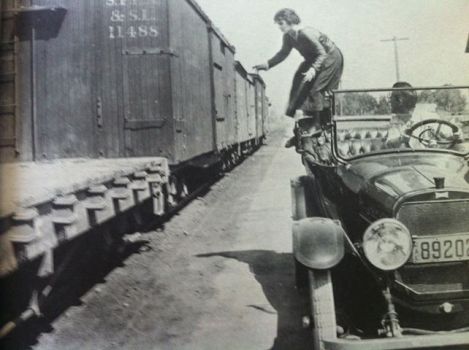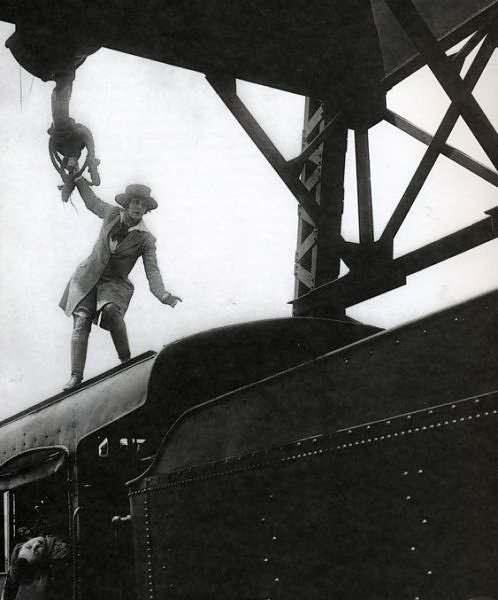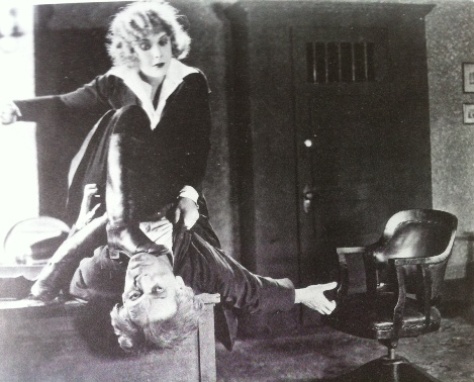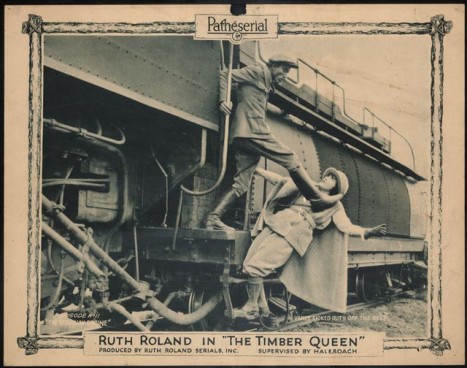We’re in a new golden age of female ass-kicking. When Gal Gadot takes up the mantle of Wonder Woman in the next Man Of Steel film, she will join popular headbusters like Katniss Everdeen, Black Widow, and Hit-Girl. These cinematic heroines, however, belong to a lineage that stretches back a hundred years—past Buffy, past Sarah Connor, past Ripley, past Foxy Brown—to the earliest days of motion pictures. Today’s female action heroes owe a lot to the serial queens of silent cinema.
In the 1910s—years before the passage of the 19th Amendment granting universal suffrage—moviegoers flocked to see weekly action serials, and during this period, the biggest stars of action films were women. Week in and week out, these heroines found themselves in ever-escalating trouble.

Mary Fuller really kicked off the trend in 1912 with her enormously popular serial What Happened To Mary. Released by Edison Studios (yes, as in Thomas Edison—that’s how far back we’re talking here), the serial told the story of a plucky young woman named Mary who goes to New York City and gets into a series of adventures (she has to avoid kidnappers, for instance, on a fairly regular basis). The serial featured episodes with titles like “The Escape From Bondage” and “The High Tide of Misfortune” and fans could follow a serialized print version of Fuller’s adventures in the mail order journal The Ladies’ World. Fuller followed up the success of her serial with a sequel (Who Will Mary Marry?) and a new serial The Active Life of Dollie of the Dailies. After these hits, however, Fuller retreated from the spotlight and stopped making films by the end of 1917.

Helen Holmes was the star of railroad adventure series The Hazards of Helen. Working with her husband and creative partner, J.P. McGowan, Holmes played a fearless railroad employee whose job constantly involved foiling robberies, stopping runaway trains, and jumping off bridges. Holmes was a stuntwoman as well as an actress, writer, director, and producer on the series.
The brave “Helen” she created was a sensation. Newspapers followed her exploits with headlines like HOUDINI OUTDONE BY HELEN HOLMES. John Wayne later claimed that when he was a teenager she was his first mad crush. “You’d think a pretty girl like Helen would be afraid of spoiling her looks,” McGowan proudly told a reporter “but nothing worries her.” Holmes and McGowan eventually left the series and moved on to other popular serials like The Girl And The Game and A Lass Of The Lumberlands.

Helen Gibson replaced Holmes as the star of The Hazards of Helen. Born Rose Wenger, she became the wife of cowboy Hoot Gibson and started her career riding in rodeos and doing stunt work in the serials. She did some stunts for Holmes during the earlier Hazards films and kept up the stunt work once she took over the lead role. A true daredevil, Gibson jumped trains, swung from ropes, and dove off buildings—and came close to getting herself killed on more than one occasion.
After Hazards came to an end (completing the longest run of any of the serials), Gibson followed them up with the successful serial A Daughter of Daring and other adventure shorts. After her popularity had diminished, she rode trick horses for the Ringling Bros. and Barnum & Bailey Wild West Show. She eventually returned to the movie business working as a stuntwoman and bit actor. Along with her friend Helen Holmes, she was one of the founding members of the Riding And Stunt Girls Of The Screen, the first union for professional stuntwoman.

Ruth Roland called her films “high class fairy tales.” She first came to the public’s notice as an armchair sleuth in 1915’s The Girl Detective, but she had her real breakout success thanks to a 14-part supernatural serial called The Red Circle which cast her as a young woman cursed with a strange scarlet mark on her hand that compels her to commit crimes. Audiences ate up the good/bad duality of the character, and their admiration turned Ruth into a superstar.
A savvy businesswoman, she used her newfound success wisely, starting her own Ruth Roland Serials, Inc. and cranking out a new hit series, The Adventures of Ruth. Here she was a fearless heiress trying to solve the murder of her father. “I wrote the story and personally supervised the taking of every scene,” she promised her adoring public. She followed up that hit with more serials like White Eagle and The Timber Queen, and The Haunted Valley. When she finally retired from the screen, she was a rich woman. According to silent film historian Larry Telles, she eventually starred in 164 serial episodes.

Pearl White, the star of The Perils of Pauline, was undoubtedly the biggest star of serials. At the height of her fame in 1914, she was probably the most famous woman in the world. Her face was recognizable not just all across America but in Europe, Asia and Africa. For many people, Pearl White was the serial queen. If she wasn’t as scrappy and working-class as Holmes or Gibson, she was more of a tomboy than Roland or Fuller.
The Perils of Pauline cast her as a young woman who comes into a fortune when her rich guardian dies. She delays getting married (a stipulation of the will) because she wants to see the world in preparation for becoming a writer. Her late guardian’s secretary, Mr. Koerner, attempting to keep the money for himself, keeps arranging for misfortune to befall her. The serial was a smash, and soon Pearl was making $3,000 a week—and keep in mind that those are 1914 dollars.
She followed up Perils with an even bigger box office success, The Exploits of Elaine. She followed that up with sequels (The New Exploits of Elaine and The Romance of Elaine), as well as new serials like The House of Hate, The Lightening Raider, and Plunder. All in all, she made 176 serial episodes, the most of any performer.
The rapidly changing movie industry was hard on the serial queens. None were able to translate their success into a lasting career in full length films, much less into the new “talking” pictures. The queens were among first human beings to become international stars, and they were also among the first to be forgotten. Mary Fuller had a series of nervous breakdowns and spent her last years in a mental hospital. Holmes lost her money in the Depression and struggled with health ailments. Roland died of cancer at the age of 45. Pearl White, biggest of them all, had the farthest to fall. Beset by health problems due to her stunt work over the years, she became dependent on pain medication and alcohol and died of cirrhosis at the age of 49.
The legacy of these women (and other dashing serial queens like Kathlyn Williams and Grace Cunard) is found among the surviving fragments of their films. Like 70% of the films from the silent era, much of their work has been lost. What remains is, however, is a fascinating look at the first golden age of female ass-kicking.
To read more about the serial queens check out Shelley Stamp’s Movie-Struck Girls, Nan Estad’s Ladies of Labor/Girls of Adventure and Karen Ward Mahar’s Women Filmmakers in Early Hollywood. For studies of individual queens see Larry Telles’s book Helen Gibson: Silent Serial Queen, John J. McGowan’s book J.P. McGowan (which features copious material on Helen Holmes), and Exporting Perilous Pauline: Pearl White and the Serial Film Craze edited by Marina Dahlquist.
Jake Hinkson is the author of the novels Hell On Church Street and The Posthumous Man, as well as the new novella Saint Homicide. He blogs at The Night Editor.











That was an awesome tidbit to read on the way to work this morning! Thanks for the historical perspective and the new appreciation for woman trendsetters/awesomeness that current culture has forgotten.
Fascinating. I always figured things like The Perils of Pauline were damsel-in-distress stories with women being placed in constant bondage and peril by men and needing to be rescued by men, but it looks like these serial heroines were quite independent and were action leads in their own right. It’s a shame more of their work hasn’t survived.
Okay, now I have to go re-read Kage Baker’s Ancient Rockets.
This is the coolest thing I’ve seen in a long time. It also takes me back to my youth and “The Perils of Penelope Pittstop,” although now it appears that if Penelope had been faithful to her movie serial inspirations, she wouldn’t have always needed the Ant Hill Mob to rescue her.
@@.-@: Actually, from what little I’ve seen of Penelope Pitstop, I think she was often shown to be rather adept at getting out of bondage and deathtraps on her own when the Mob was slow to arrive.
Absolutely fascinating. I had heard of Perils of Pauline (because it is mentioned in a Black Stallion book, of all things), but not of the others.
I loved reading this! Now I need to read a lot more – and try to find some clips on YouTube!
Betty Hutton starred in a Pearl White biopic, The Perils of Pauline. It’s a lot of fun if you can take the dose of anti-feminism injected by the (totally made up) romantic plot. Very little resemblance to Pearl White’s actual life, but got quite a bit of her spirit, I think.
Must agree with those who say that this was informative and educational. Now I know who started action women in film. Sadly it’s become much more sexualized today, given the evolution of women in action in film, as thi video shows:
http://www.youtube.com/watch?v=i_ubv1GtvPI
.